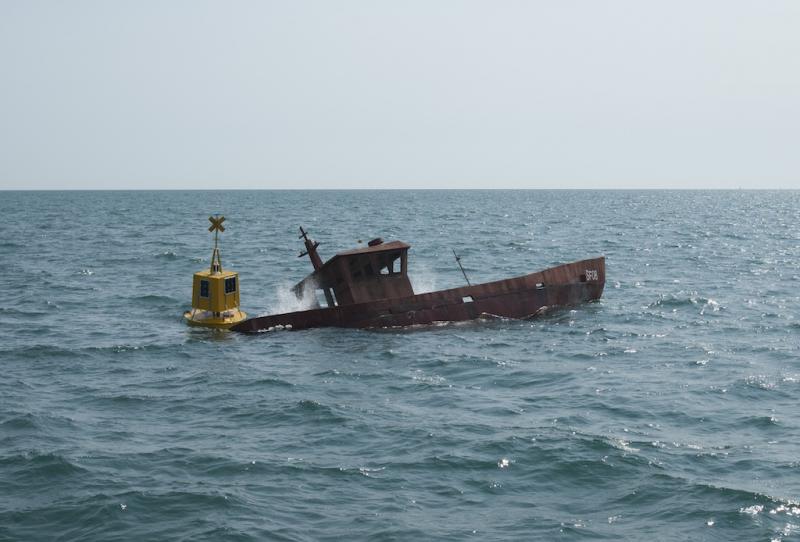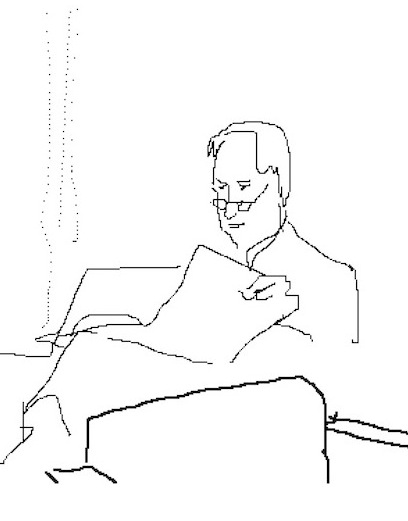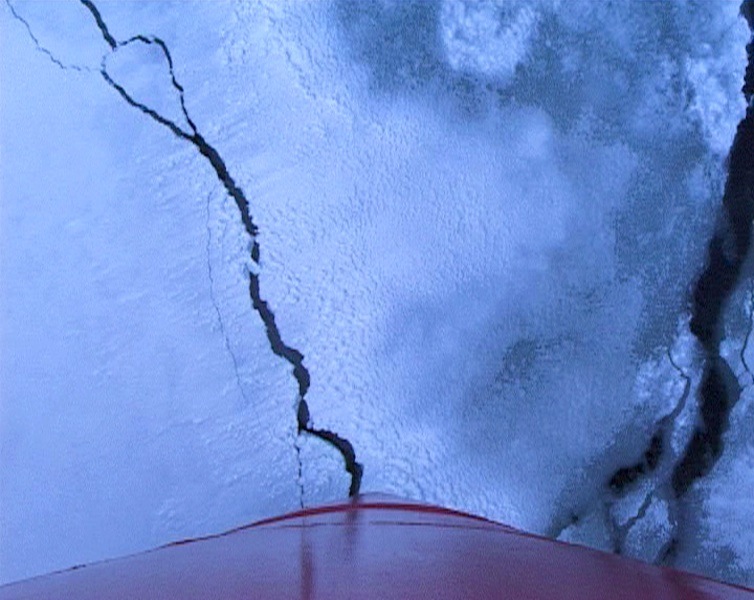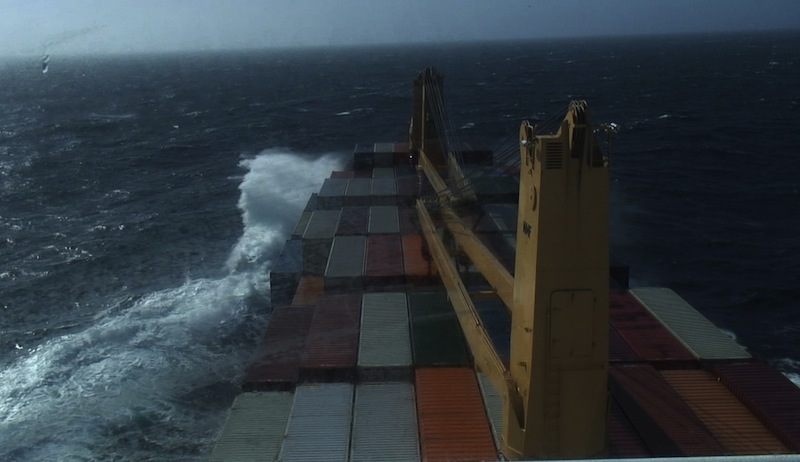theartsdesk in Calais: Simon Faithfull – To the Bottom of the World and Back | reviews, news & interviews
theartsdesk in Calais: Simon Faithfull – To the Bottom of the World and Back
theartsdesk in Calais: Simon Faithfull – To the Bottom of the World and Back
Online messages sent from elsewhere by an artist who loves the sea

The sea is the theme uniting Simon Faithfull’s mid-career retrospective. It makes the port of Calais the perfect host for this splendid exhibition and, to put you in the mood, ideally you should make the crossing by boat. Faithfull spent six days going back and forth, back and forth on the P&O ferry between Dover and Calais.
The artist has been sending drawings back from remote places since 2000, when he began communicating live from the ends of the earth “as a record”, he says, “of me being there, at that moment, on the planet.” The most recent drawing is of the Splendid Hotel in Ouagadougou, capital of Burkina Faso, which Faithfull visited in January while following the Greenwich Meridian south through France, Spain and Africa. To avoid the police in Algeria he had to hide in the bed of a truck. Mali proved too dangerous to cross because of the Tuareg rebels in the north; by the time you read this review, though, he will be sending sketches back from Ghana.
 “I like to check whether the world exists when I am not there,” Faithfull tells me by way of explaining his insatiable desire for travel. It took him westwards across the Atlantic on a container ship from Liverpool England to Liverpool, Nova Scotia. On video, we see the view from the bridge of the deck crowded with shipping containers (pictured below), and the spookily empty interior of the 180 metre long vessel as it ploughs through the water, apparently with no crew. The drawings made on board have since been sandblasted onto the paving stones and glazed arches of Liverpool’s newly refurbished Central Station.
“I like to check whether the world exists when I am not there,” Faithfull tells me by way of explaining his insatiable desire for travel. It took him westwards across the Atlantic on a container ship from Liverpool England to Liverpool, Nova Scotia. On video, we see the view from the bridge of the deck crowded with shipping containers (pictured below), and the spookily empty interior of the 180 metre long vessel as it ploughs through the water, apparently with no crew. The drawings made on board have since been sandblasted onto the paving stones and glazed arches of Liverpool’s newly refurbished Central Station.
Another epic voyage, in 2005, took him to Antarctica – “the bottom of the world” – with a boat-load of scientists on their way to the Halley Research Centre. The trip aboard RSS Ernest Shackleton took two months and 44 records the view through the porthole during those seemingly endless days. Changing colour in response to the weather conditions outside – from dull grey to shining silver to salmon pink – the circular window frame is like a continually morphing abstract painting. It encloses a view that varies from glittering moonlight dancing over sparkling water to total whiteout as a blizzard engulfs the scene. As the ship nears the coastal ice cliffs, icebergs begin to float by (pictured below right), birds fly into view and, alarmed by the arrival of the alien craft, king penguins skuttle off to safety.
 Taken from the prow of the vessel, Falling (pictured left) records the pack ice cracking open as the boat forces its way through. Projected onto the gallery wall with no frame of reference, the image looks like a waterfall of ice plummeting downwards.
Taken from the prow of the vessel, Falling (pictured left) records the pack ice cracking open as the boat forces its way through. Projected onto the gallery wall with no frame of reference, the image looks like a waterfall of ice plummeting downwards.
On the return journey, the ship stopped briefly at Stromness, the whaling station on the island of South Georgia that Ernest Shackleton managed to reach in 1917 after his boat got stuck in the Arctic ice. Abandoned since 1961, the derelict buildings are now home to a colony of sea lions. Stromness (video link below) offers a surreal view of the wild life snoozing amidst decaying furniture and rotting industrial machinery as, on Midsummer’s day, the snow falls and the wind rattles the corrugated iron sheeting of this eerie ghost town.
His most recent venture involved the deliberate creation of a ruin for other species to inhabit. Last August a defunct fishing vessel was towed out to sea, set on fire and sunk to the bottom of the English Channel near Weymouth (main picture). Bought on ebay for £75, the Brioney Victoria began a new life 20 metres below the waves as a reef colonised by marine organisms. Faithfull’s installation Reef shows the vessel going down, while five on-board cameras relay pictures of the interior being engulfed by water and the first fish arriving to take possession.
 The moment the boat is swallowed up still carries an emotional punch, despite the fact that one knows it was deliberately scuppered. As a maritime nation whose history has been intimately bound up with the sea, fear of the destructive power of the ocean must be embedded in our DNA. Faithfull’s obsession comes, he tells me, “from the fact that, after spending weeks at sea, you realise that the land we value so highly is insignificant when compared with the vast expanses of the ocean.”
The moment the boat is swallowed up still carries an emotional punch, despite the fact that one knows it was deliberately scuppered. As a maritime nation whose history has been intimately bound up with the sea, fear of the destructive power of the ocean must be embedded in our DNA. Faithfull’s obsession comes, he tells me, “from the fact that, after spending weeks at sea, you realise that the land we value so highly is insignificant when compared with the vast expanses of the ocean.”
The drawings and videos, which are also available online for anyone to access, are his way of “reporting back from the extremities of the earth”. Why, though, should we take this self-styled explorer seriously when his absurdist projects are of no obvious benefit to humanity? First off, he makes his unrealistic dreams come true, when convincing others that a mission is worthwhile requires cast iron conviction. Gaining the necessary permissions to sink the boat, for example, took four years of unwavering commitment.
More important, though, is the quality of the images sent back. Charmingly inconsequential observations of daily life, the drawings mirror the unthinking way most of us conduct our lives. The videos, on the other hand, are hauntingly melancholic meditations on what it means, on a deeper level, to live on a planet that few of us bother to explore or even to consider much.
 Travelling to the periphery affords Faithfull an overview denied those of us stuck in the thick of it. His videos fulfil a similar function to an exotic holiday. They provide a chance to escape to remote and often empty places, and also the mental space to ponder some of those important questions.
Travelling to the periphery affords Faithfull an overview denied those of us stuck in the thick of it. His videos fulfil a similar function to an exotic holiday. They provide a chance to escape to remote and often empty places, and also the mental space to ponder some of those important questions.
- Simon Faithfull: RECIF 2 at the Musée des beaux-arts Calais until 22 June
- Simon Faithfull's Limbo app and Reef project website
Watch a clip of Simon Faithfull's Stromness overleaf
Explore topics
Share this article
more Visual arts
 Stephen review - a breathtakingly good first feature by a multi-media artist
Melanie Manchot's debut is strikingly intelligent and compelling
Stephen review - a breathtakingly good first feature by a multi-media artist
Melanie Manchot's debut is strikingly intelligent and compelling
 Fantastic Machine review - photography's story from one camera to 45 billion
Love it or hate it, the photographic image has ensnared us all
Fantastic Machine review - photography's story from one camera to 45 billion
Love it or hate it, the photographic image has ensnared us all
 Yinka Shonibare: Suspended States, Serpentine Gallery review - pure delight
Weighty subject matter treated with the lightest of touch
Yinka Shonibare: Suspended States, Serpentine Gallery review - pure delight
Weighty subject matter treated with the lightest of touch
 Jane Harris: Ellipse, Frac Nouvelle-Aquitaine MÉCA, Bordeaux review - ovals to the fore
Persistence and conviction in the works of the late English painter
Jane Harris: Ellipse, Frac Nouvelle-Aquitaine MÉCA, Bordeaux review - ovals to the fore
Persistence and conviction in the works of the late English painter
 Sargent and Fashion, Tate Britain review - portraiture as a performance
London’s elite posing dressed up to the nines
Sargent and Fashion, Tate Britain review - portraiture as a performance
London’s elite posing dressed up to the nines
 Zineb Sedira: Dreams Have No Titles, Whitechapel Gallery review - a disorientating mix of fact and fiction
An exhibition that begs the question 'What and where is home?'
Zineb Sedira: Dreams Have No Titles, Whitechapel Gallery review - a disorientating mix of fact and fiction
An exhibition that begs the question 'What and where is home?'
 Yoko Ono: Music of the Mind, Tate Modern review - a fitting celebration of the early years
Acknowledgement as a major avant garde artist comes at 90
Yoko Ono: Music of the Mind, Tate Modern review - a fitting celebration of the early years
Acknowledgement as a major avant garde artist comes at 90
 Unravel: The Power and Politics of Textiles in Art, Barbican review - the fabric of dissent
An ambitious exploration of a neglected medium
Unravel: The Power and Politics of Textiles in Art, Barbican review - the fabric of dissent
An ambitious exploration of a neglected medium
 When Forms Come Alive, Hayward Gallery review - how to reduce good art to family fun
Seriously good sculptures presented as little more than playthings or jokes
When Forms Come Alive, Hayward Gallery review - how to reduce good art to family fun
Seriously good sculptures presented as little more than playthings or jokes
 Entangled Pasts 1768-now, Royal Academy review - an institution exploring its racist past
After a long, slow journey from invisibility to agency, black people finally get a look in
Entangled Pasts 1768-now, Royal Academy review - an institution exploring its racist past
After a long, slow journey from invisibility to agency, black people finally get a look in
 Barbara Kruger, Serpentine Gallery review - clever, funny and chilling installations
Exploring the lies, deceptions and hyperbole used to cajole, bully and manipulate us
Barbara Kruger, Serpentine Gallery review - clever, funny and chilling installations
Exploring the lies, deceptions and hyperbole used to cajole, bully and manipulate us
 Richard Dorment: Warhol After Warhol review - beyond criticism
A venerable art critic reflects on the darkest hearts of our aesthetic market
Richard Dorment: Warhol After Warhol review - beyond criticism
A venerable art critic reflects on the darkest hearts of our aesthetic market

Add comment